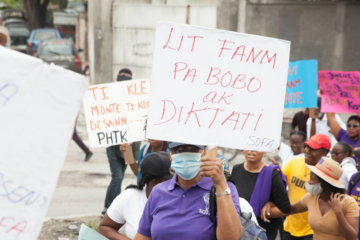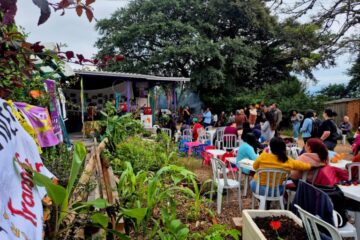In today’s context the U.S. empire, reacting to its own decline, fuels today’s wars and conflicts while laying the groundwork for new ones. Wars, conflicts, and militarization manifest in new ways: these are wars over natural resources, hybrid wars, and asymmetric wars, all characterized by extreme violence and deepening inequalities. Examples include the Palestinian genocide, conflicts involving neighboring territories such as Iran and Lebanon, forced displacements in Sudan, crises caused by sanctions in Cuba and Venezuela, and the strengthening of war entities like the North Atlantic Treaty Organization (NATO).
As defined by the World March of Women (WMW), these are “expressions of violence that have been naturalized within the patriarchal capitalist system, just as they are the tools used by this system to maintain its domination.” This understanding encompasses the many forms of militarized occupation and exploitation of women’s territories, bodies, and labor, and is part of the feminist perspective that the WMW brings to the struggle against war. It is clearly expressed in the slogan of the movement’s 6th International Action in 2025: “We march against wars and capitalism, we defend the sovereignty of peoples and good living.”
The virtual activity “Feminist Vision for Peace in the Asia-Pacific Region,” organized by the WMW, with moderation of Asma Aamir, Subtitude Member for Asia in International Committee of World March Of Women, and Women in Struggle for Empowerment (WISE), was part of the 6th International Action’s calendar. During the event, Ana Maria Nemenzo, from WMW Philippines, shared how the United States remains a major threat in the region, endangering national sovereignty and creating conflict scenarios with China: “The Philippines has been caught in this ongoing political economic rivalry between the US and the emerging power of China. But not only in the region, the US has been very aggressive, intruding in all the internal national affairs of countries across the world, whether it is Europe, Middle East, Asia, and so on.”
The occupation of Asian territories by U.S. military bases puts many women in the region at risk of abuse and sexual violence. In response, they have formed international coalitions such as International Women’s Network Against Militarism and Stop the War Coalition to denounce these violations and bring them before the judicial system.
Gayani Gomes, from WMW Sri Lanka, shared how feminism is women’s main tool for building peace. Still, according to her, the absence of war does not necessarily mean peace for women: “For many women in Sri Lanka, the end of the war in 2009 didn’t bring real peace. It marked the start of a new chapter of the survivors. Especially when it comes to the north and east regions, thousands of women became widows, headed off households and they were forcibly displaced. Many faced violences, particularly sexual violences and yet their stories were pushed to the margins — these women were not represented in peace discussions.”
Even the peace negotiation processes failed to consider the demands of women seeking healing, justice, and dignity—going beyond mere ceasefire agreements.
Bangladesh has also experienced continuous militarization since its 1971 war of independence. Salima Sultana, from WMW Bangladesh, explains that during the war, about 200,000 women were victims of sexual violence. Although they were officially recognized as birangona (heroines), these women were marginalized after the conflict: “The war altered traditional gender roles temporarily as many women assumed responsibilities typically held by men, caring for families, participating in resistance, and managing their household resources under the crisis. After the war, their power in the decision-making process in the post-war patriarchal structure was restrained, and women were forced back into their traditional caregiving roles,” she explains.
A lasting consequence of the post-war period in Bangladesh was the resource management crisis, culminating in the Great Famine of 1974, which killed 1.5 million people. Militarization and land occupation are also present realities in the country, as in other parts of the Asia-Pacific region. In the Chittagong Hills, for example, Indigenous women have lost their lands, affecting local food production as well.
Women’s Peace
The challenges women face in peace processes include systematic exclusion, institutional patriarchy, and the fear of retaliation and repression. Through organization and mobilization, women advocate for a peace that prioritizes social justice, access to land, and food sovereignty. For peace to be lasting, women’s demands for justice and reparation must be at the center of negotiations.
In the context of the recent conflict between India and Pakistan, feminist movements from both and other countries were key in expressing concrete solidarity by organizing ceasefire campaigns. Bushra Khalik, from WMW Pakistan, shared that feminists condemn the conflict in Pahalgam and all forms of global extremism: “The role of the civil society organizations and the feminist movement is to publicize our statements. We the women, and as citizens of Pakistan, we do not want a war in this region or in the cross borders. We emphasized on starting the dialogues between both countries at the diplomatic level, at the state level and at the people’s level. We took the roads and we demonstrated and we took on a peaceful rally under the banner of WISE and other organizations and we demanded peace – sustainable peace for the people,” she says.
Feminist organizations also played a key role in Sri Lanka after the 2009 war, especially in documenting events and violations suffered by women. Salima highlighted how these organizations were crucial to processes of truth and memory: “Women’s groups such as the Women’s Development Federation, Women’s Action Network, Mothers and Daughters of Lanka — which is a network owned by the Women’s Center — and a network of mothers of disappeared people have documented sexual violences, land dispossession, disappearances and other tactics as well. These efforts highlighted the experiences of special marginalized communities in Sri Lanka, such as Tamil people, Muslims, and the Sinhala people. These women were not erased, actually they have laid the foundation for a people-centered reconciliation process. Without the truth, we cannot go for a genuine peace.”
The fight for peace in Sri Lanka involves demanding greater representation of women in political and decision-making spaces and denouncing the heavy militarization still present in society. In predominantly Tamil areas, the military presence is intense, and women face daily surveillance, intimidation, and restricted freedom of movement. Salima noted: “Feminist groups boldly challenge this reality, arguing that demilitarization is not a side issue, it is central to the peace as well. So peace means freedom from violence, whether from armed groups or state forces.” Women recognize the importance of economic justice for sustainable peace, especially for those in the north and east who continue to work in precarious sectors. Organizations like the Women’s Centre and WMW provide legal support and mobilize for fair wages—understanding that peace is also about access to income, housing, education, and food security.
In the Philippines, Ana Maria emphasized the importance of grassroots mobilization, feminist networks, and public advocacy in resisting militarization. She shared the innovative experience of organizing civilian fishing boat convoys to defend territorial sovereignty and the livelihoods and working conditions of fishers in the South China Sea, an area increasingly marked by Chinese naval presence. “This is a very big task because they have involved movements and entertainers from Korea, Taiwan, and local entertainers to hold a concert in the South China Sea near the islands to support the fisher folk who have been using these waters,” she says.
International solidarity among women is essential to resist the normalization of war. Through local and global alliances, women shed light on the capitalist, racist, and patriarchal roots of conflicts and center feminist voices in peace processes. Yildiz Temürtürkan, coordinator of the International Secretariat of the WMW, stressed the importance of connecting feminist movements internationally. The World March of Women is a powerful space for building shared struggles and convergence.
Since the beginning, the World March of Women has been active in this field [peace and demilitarization]. In [the year] 2000, right after we submitted our demands to the United Nations with a big global campaign and action, they have adopted a resolution called the UN Resolution 1325, that gives a special status of participation of women in peace process. We had a very important demonstration during the NATO summit in Quebec against the invasion and occupation of Afghanistan. In 2005, we organized a demonstration in many countries that have conflict in the borders. In 2010, we had an important action in the Democratic Republic of Congo. In 2015, we had the feminist caravan on the border of Syria. It was very important moment at that time, as the jihadists were attacking women and threatening their rights. And now we are having our global action in Nepal.
Yildiz Temürtürkan
At a time when the fight for peace is at the forefront in many parts of the world, the WMW will conclude its 6th International Action in Nepal. The choice of the region presents an opportunity to bring together women from international peace movements to learn and share their struggles. As Yildiz explained: “This is a concrete step taken inside our 6th International Action on the International Peace Day on September 21st, to have a broader alliance for peace in the region and also at international level.”




